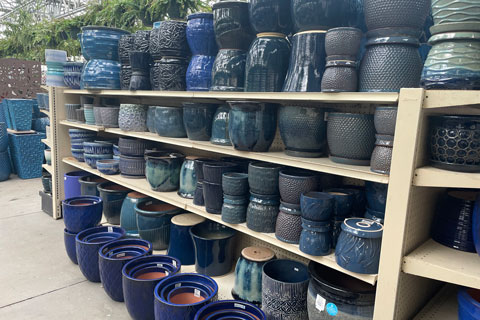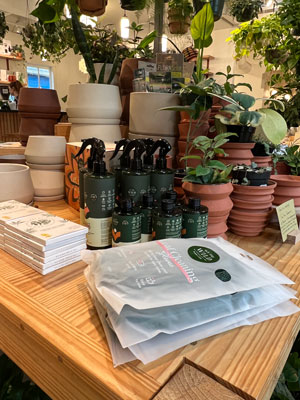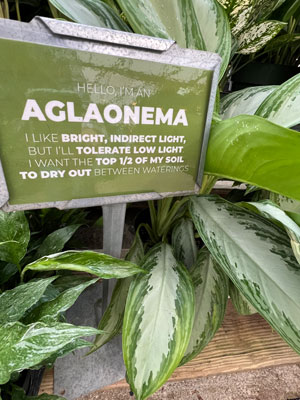5/1/2024
Making Adjustments
Jennifer Polanz

The houseplant market is changing and evolving as more product becomes readily available for retailers and boutique houseplant shops, and as customers get farther into their plant parent hobby. So what’s the advantage for independent retailers right now?
Retail Consultant Sid Raisch, owner of Horticultural Advantage, pointed out there’s still opportunity in the category and to not take your eye off the ball.
Pictured: Pottery is a big seller at Wallace’s Garden Center in Bettendorf, Iowa. They have some pots merchandised nearby the houseplant department.
“I still think there’s a lot of room ahead,” he added. “We have a lot more consistent supply because of this most recent surge [from COVID] and the resellers have done a good job.”
His reminder is twofold: retreating from a category is a self-fulfilling prophecy and this was the gateway for a young crowd to come into the garden center. Why risk losing them when you just got them?
He noted the average lifespan for a houseplant is around three to four years, and they’re constantly in need of being repotted and fertilized for optimum performance. Those are all opportunities to continue with replacing plants, pottery, fertilizer, specialized potting soil and other accessories that bring customers back into the store. Also, don’t assume everyone has all the houseplants they want, he said, or understands how to grow them all. There’s lot of opportunity for education and expansion into different plant types, even for casual plant parents.
“Design is an opportunity. Help people design plants into their spaces,” he said. “Good design isn’t made up of a collection of ‘onesies;’ it takes repetition, contrast and mass, among others, to design a room with houseplants included.”
Let’s Strategize
Kate Terrell, president of Wallace’s Garden Center in Bettendorf, Iowa, said they redesigned their houseplant department to freshen up the look and make it more open and inviting. She’s seeing solid foot traffic this year so far.
“Definitely not panic buyers of 2021, but a lot more plants for gifting,” she noted. “We also went back to smaller orders, but more frequently so we can get people coming in every week to see what is new.”
 Pictured: Merchandising products to simplify choice and make buying decisions easier can help improve sales and result in greater success.
Pictured: Merchandising products to simplify choice and make buying decisions easier can help improve sales and result in greater success.
That foot traffic is vital for houseplants especially, so her social media specialist partnered up with the houseplant potting bench specialists to make sure they posted on social media channels each time someone got a plant repotted at the store.
“She posts a little collage on Instagram or Facebook of the different plant/pot styling,” Kate said. “I think it helps give people ideas.”
Speaking of repotting plants, they have an ongoing promotion where customers get a free potting service if they buy the houseplant and a pot, which helps to keep pottery in the line of sight, too (that’s a strong category all around for Wallace’s). And, for good measure, her employees are great about talking up the products they’re using as they’re potting up the plants, like the fertilizer, moisture meters, soils, etc. Customers leave with the whole package, which helps in their ongoing success.
She’s seeing sales tick up for houseplant fertilizers, too. That’s a cycle—it depends on how much they bought to begin with since a little can go a long way. But if they continue to have houseplants, they’ll continue to be back for more.
More Ways to Keep It Fresh
For the past three years, Benken Garden Center & Florist in Cincinnati has hosted a Houseplant Expo in the late winter. These types of events are a way to drive foot traffic, educate customers, sell lots of a specific department—including accessories—and bring in offseason revenue. This year, they stocked up on houseplants and offered customers 20% off all houseplants the whole day of the event.
There were paid workshops customers could register for, like a Succulent Garden, Stained Glass Airplant Hanger and Teacup Succulent Garden, as well as free seminars about specific topics related to houseplants. It was all over their socials, including photos from the day of the event.
Sid noted there are other activities and events that can tie into houseplants while also highlighting another big goal of customers: sustainability. For example, he said garden centers have done pottery trade-ins where customers bring back older pots in exchange for discounts on new ones. Often these pots get donated to garden clubs or kids gardening organizations since they’re typically one-offs. But if you have other ideas for how to use them, more power to you!
He also said retailers have had success with poinsettia trade-ins where customers bring in their dying (or dead!) poinsettias in January in exchange for a houseplant or discount on a houseplant. Whatever you do, the goal is to stay in front of the customer with your messaging for the department—many times they aren’t ones that are going to drop their interest in houseplants during peak spring.
“The surge may be over, but the business isn’t unless we allow it to die from lack of attention and focus,” Sid added. “Let attrition or decline in the demand be taken up by other sellers.”
Leaning In
Joshua Armstrong is the founder of We the Wild, a plant care brand that offers fertilizers and other plant care accessories. He mentioned “adventure gardening” when I talked to him about houseplant trends and how experienced plant buyers are looking for new plants.
“They’re looking for more risks. They’re looking for plants that might be a little bit more challenging, they might be looking at propagation,” he said. “They’re looking for things that aren’t your standard fiddle leaf fig.”
 That means more plant care and more education to help them stay successful. Oh, and he said they’re looking for year-round selection, not just during a few times a year. They buy houseplants like they buy a new candle or couch, i.e. whenever they decide they need a new one.
That means more plant care and more education to help them stay successful. Oh, and he said they’re looking for year-round selection, not just during a few times a year. They buy houseplants like they buy a new candle or couch, i.e. whenever they decide they need a new one.
As a plant care brand, too, he sees a need for more focus on the health of the plant right away, rather than waiting for the customer to come back with a dying plant. That’s why they’ve created kits, so customers can go home with the complete package on Day 1 to be successful (they’re working on a new Winter Grow kit, too, that includes their fertilizer, grow concentrate and grow lights). In fact, he noted the biggest pain points continue to be pests, lighting and feeding for houseplant consumers. Creating a simplified selection of products to solve those issues will go a long way to keeping the houseplant department steady.
Pictured: Benken Garden Center & Florist in Cincinnati uses signs to educate on one of the biggest challenges for consumers: lighting.
One more thing Joshua highlighted during our chat is that a high percentage of houseplants are given as gifts (remember Kate said she’s seeing more plants for gifting, too). Retailers can continue to capitalize on this segment by offering complements to the houseplant for additional ways to build the perfect gift—for example, a gift set for Mother’s Day. In one section you could merchandise gift components together with plants or create your own gift sets to show how a gift basket could come together for someone special.
And, finally, he said to lean on your partners, who likely have social media assets, point-of-sale materials and other resources that can help you increase sales. Take advantage of that and they’ll help you be in the houseplant business for a long time. GP